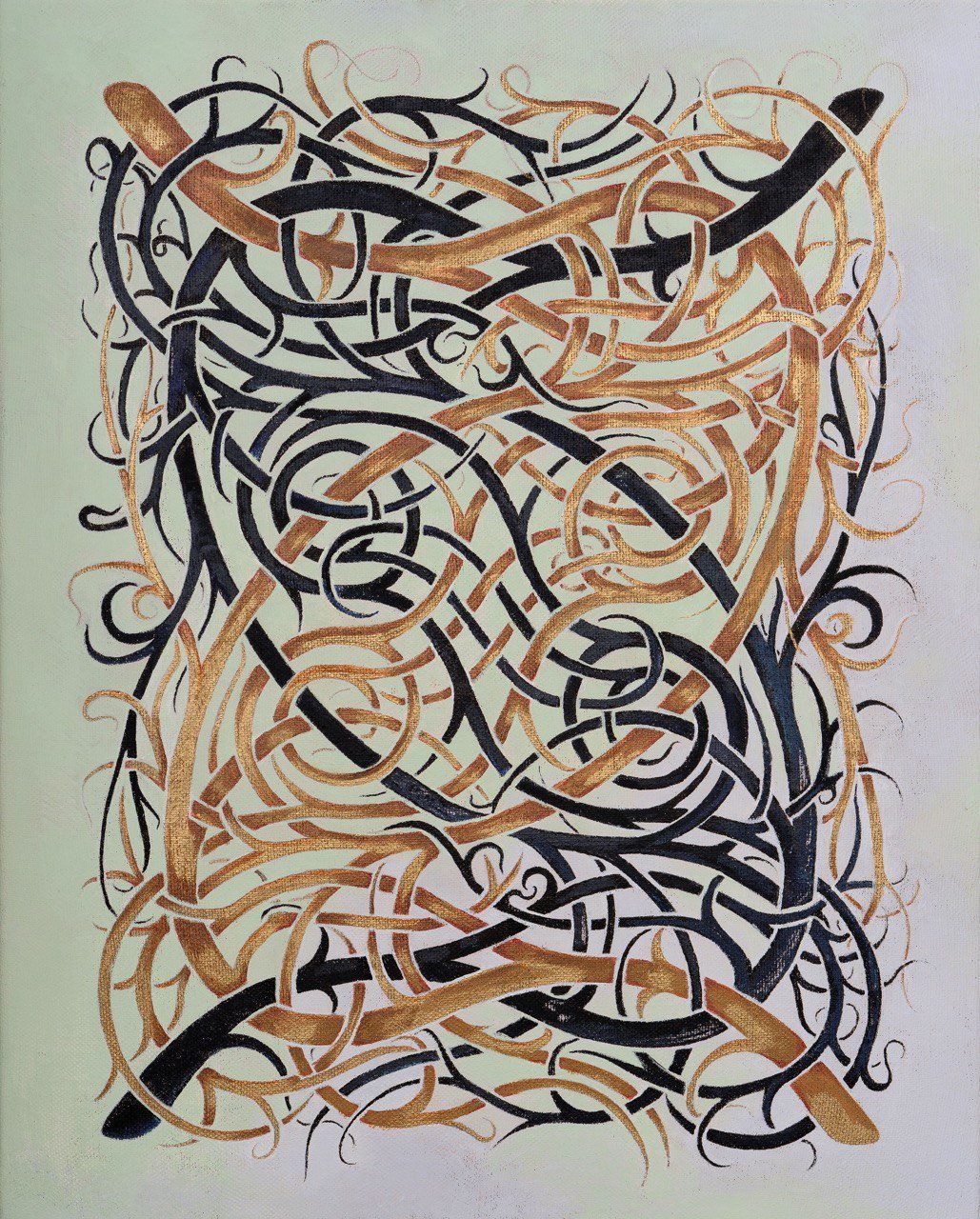Selected Works
Peter Gil's work occupies a significant position at the intersection of several important contemporary art movements. His practice represents a sophisticated engagement with post-folk aesthetics, critical regionalism, and the broader discourse on cultural heritage in the age of globalization.
OIL & MIXED MEDIA PAINTINGS
Elaborate compositions of Peter Gil shine bright in the painted artworks. The oils and mixed media artworks provide a varied textures and colours to provide deeper insight into artist’s point of view
DIGITAL ARTWORKS
Digital Studies by Peter Gil are an open series of abstract drawings exploring various kociewian etnographic motiffs and heritage symbolism.
While the overall theme of the works is rather minimal, a little synthetic, the works are a nod to the original kociewian embroidery guide plates, that were handed over through friends and families across the years.
Gil's distinctive visual language, characterized by the deconstruction and recontextualization of traditional Kociewian folk patterns places him within a lineage of artists who have sought to revitalize cultural heritage through contemporary artistic frameworks.
However, unlike many predecessors who approached folk traditions with ethnographic distance or nostalgic sentimentality, Gil's work is marked by an intimate knowledge of these traditions combined with a critical awareness of their place in contemporary society.
Historical and Contemporary Context
-
Gil's practice can be understood as part of a significant historical trajectory in Eastern European art that has engaged with folk traditions as sites of cultural resistance and renewal. This lineage includes:
The Polish avant-garde of the interwar period, particularly artists associated with the Formists group (1917-1922), who sought to develop a distinctly Polish modernism by synthesizing international avant-garde styles with references to folk art and local traditions.
The Polish Colorists of the 1930s, who, influenced by Post-Impressionism, developed a distinctive approach to color that often incorporated elements from Polish folk traditions.
Gil's work extends this lineage while introducing contemporary concerns about globalization, cultural identity, and the politics of heritage preservation.
-
Within the contemporary art landscape, Gil's practice resonates with several significant movements and theoretical frameworks:
1. Post-Folk and Neo-Vernacular Movements
Gil's work contributes to the international discourse on post-folk aesthetics, a movement characterized by artists who engage with folk traditions not as ethnographic subjects but as living cultural resources. His approach aligns with artists like:
Grayson Perry (UK), whose ceramics and textiles recontextualize traditional craft techniques within contemporary art narratives
Jaune Quick-to-See Smith (US), who incorporates indigenous visual languages into contemporary painting to address cultural identity and colonialism
Lubaina Himid (UK), whose work engages with cultural heritage and identity through contemporary formal languages
Gil's distinctive contribution to this discourse lies in his specific engagement with Kociewian folk patterns and his emphasis on the emotional and psychological dimensions of cultural heritage.
2. Critical Regionalism
Gil's practice exemplifies principles of Critical Regionalism, a theoretical framework first articulated by architectural theorists Kenneth Frampton and Alexander Tzonis, but increasingly applied to contemporary art. This approach:
Resists both homogenizing globalization and reactionary regionalism
Engages with local traditions while maintaining a critical dialogue with global contemporary art
Emphasizes the embodied, phenomenological experience of place and culture
Gil's work demonstrates these principles through its sophisticated negotiation between Kociewian folk traditions and contemporary abstract expression, creating what might be termed a "critical vernacular" that is simultaneously rooted and cosmopolitan.
3. Post-Medium Condition
Gil's mixed-media approach places him within what art theorist Rosalind Krauss has termed the "post-medium condition" of contemporary art. His work:
Transcends traditional medium-specific categories
Employs diverse materials and techniques as conceptual strategies rather than technical ends
creates meaning through the tension between traditional craft techniques and contemporary artistic methodologies
4. The Archival Turn
Gil's engagement with cultural heritage participates in what has been called the "archival turn" in contemporary art—a growing interest in archives, cultural memory, and historical retrieval as artistic strategies. His work:
Treats Kociewian folk patterns as a living archive rather than static historical artifacts
Employs strategies of sampling, remixing, and recontextualization
Creates new meanings through the juxtaposition of historical elements with contemporary concerns
-
What distinguishes Gil's practice within these broader movements is his unique synthesis of:
Authentic Cultural Immersion: Unlike many contemporary artists who engage with folk traditions from an external perspective, Gil's work emerges from lived experience and deep cultural knowledge of Kociewian traditions.
Formal Sophistication: Gil's compositions demonstrate a refined understanding of contemporary abstract language, creating works that function simultaneously as cultural documents and autonomous aesthetic objects.
Emotional Resonance: Beyond formal or conceptual concerns, Gil's work maintains a powerful emotional dimension, addressing universal human experiences of belonging, memory, and identity.
Material Innovation: His experimental approach to materials—combining traditional techniques with contemporary processes—creates works that embody the very tension between tradition and innovation that they thematically address.
-
Within the contemporary art market, Gil's work occupies a significant position at the intersection of several valuable collecting categories:
Contemporary Eastern European Art: A growing sector with increasing international recognition and institutional support
Heritage-Engaged Contemporary Art: Collected by both private and institutional buyers interested in cultural preservation and identity
Abstract Painting with Conceptual Depth: Appealing to sophisticated collectors who value both formal qualities and conceptual frameworks
Cross-Cultural Dialogue: Attractive to international collectors interested in global artistic conversations beyond Western-centric narratives
Gil's market trajectory aligns with artists like Mircea Cantor, Paulina Ołowska, and Adrian Ghenie, who have successfully translated Eastern European cultural contexts into internationally recognized artistic languages.




